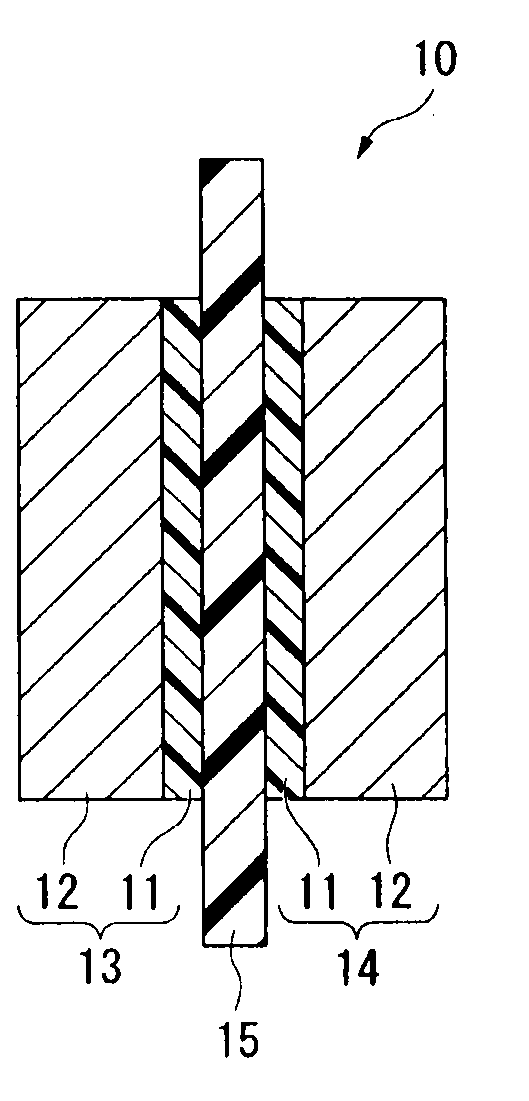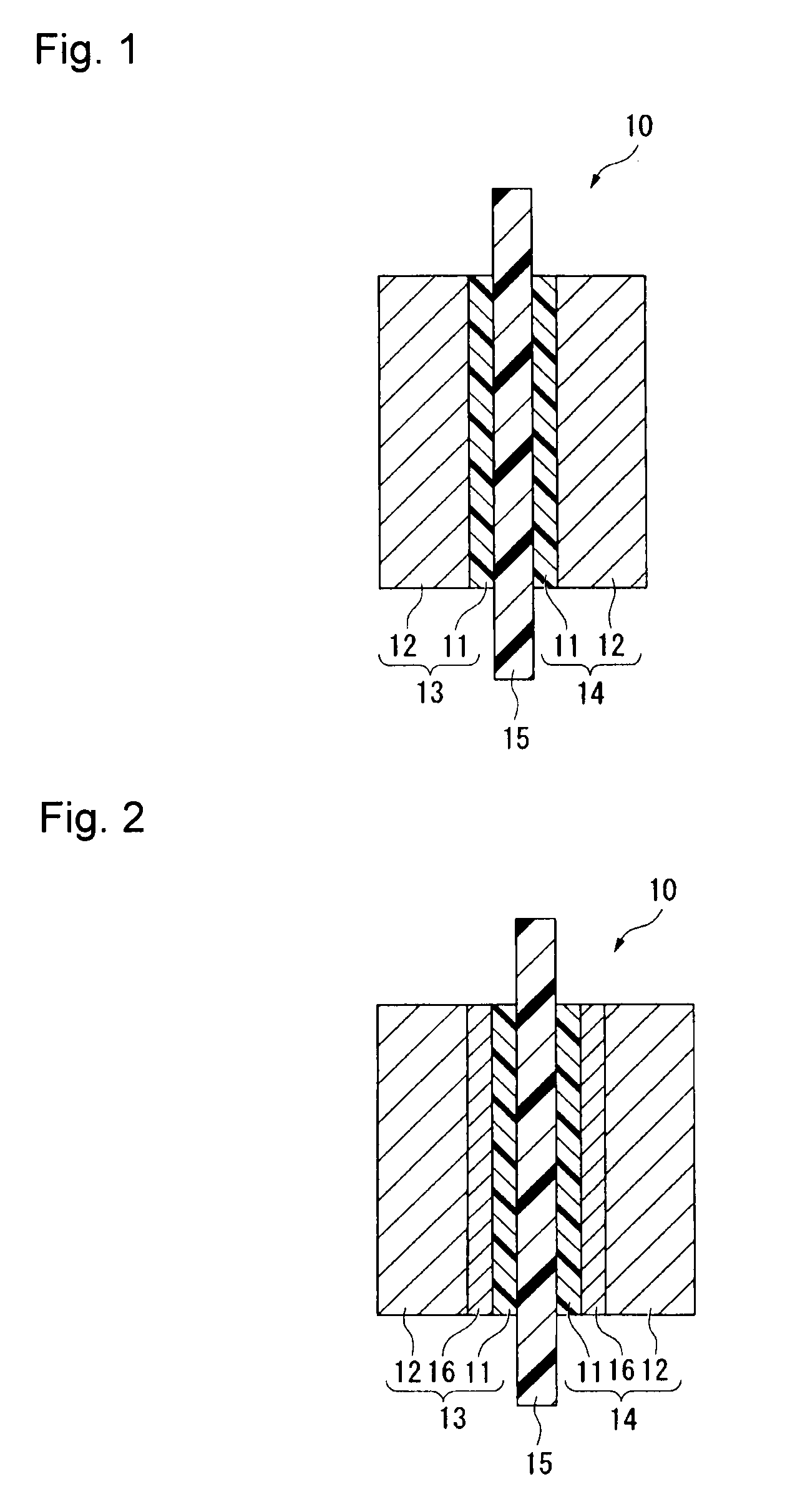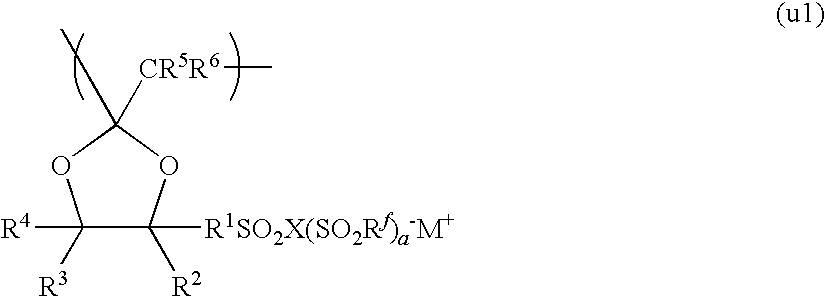Electrolyte material, liquid composition and membrane/electrode assembly for polymer electrolyte fuel cell
a technology of electrolyte fuel cell and electrolyte, which is applied in the direction of sustainable manufacturing/processing, conductors, and final product manufacturing, can solve the problems of difficult to increase ion exchange capacity, and easy to block pores (flooding) by condensation of water vapor in the catalyst layer, etc., and achieve excellent power generation characteristics and suppress the effect of water content increas
- Summary
- Abstract
- Description
- Claims
- Application Information
AI Technical Summary
Benefits of technology
Problems solved by technology
Method used
Image
Examples
example 1
[0176]Into a stainless steel autoclave having an internal capacity of 125 mL, 9.16 g of compound (m1-1), 5.67 g of compound (m2-1), 5.0 g of compound (s-1) and 2.4 mg of compound (i-1) were charged, followed by sufficient deaeration under cooling with liquid nitrogen. Then, the temperature was raised to 65° C., followed by stirring for 23.5 hours, and then the autoclave was cooled to terminate the reaction.
[0177]The formed product was diluted with compound (s-1), and n-hexane was added thereto to agglomerate a polymer, followed by filtration. Then, the polymer was stirred in compound (s-1), re-agglomerated with n-hexane and dried under reduced pressure overnight at 80° C. to obtain polymer (F-1). The yield was 6.35 g. Using polymer (F-1), TQ of polymer (F-1) and the ion exchange capacity and the water content of polymer (H-1) were measured. The results are shown in Table 1.
[0178]Polymer (F-1) was immersed in an aqueous solution containing 20 mass % of methanol and 15 mass % of potas...
example 2
[0180]Into a stainless steel autoclave having an internal capacity of 125 mL, 9.26 g of compound (m1-1), 5.03 g of compound (m2-1), 17.5 g of compound (s-1) and 28.3 mg of compound (i-1), were charged, followed by sufficient deaeration under cooling with liquid nitrogen. Then, the temperature was raised to 65° C., followed by stirring for 8 hours, and the autoclave was cooled to terminate the reaction.
[0181]The formed product was diluted with compound (s-1), and n-hexane was added thereto to agglomerate a polymer, followed by filtration. Then, the polymer was stirred in compound (s-1), re-agglomerated with n-hexane and dried under reduced pressure overnight at 80° C. to obtain polymer (F-2). The yield was 9.8 g. Using polymer (F-2), TQ of polymer (F-2) and the ion exchange capacity and the water content of polymer (H-2) were measured. The results are shown in Table 1.
[0182]Using polymer (F-2), polymer (H-2) and liquid composition (D-2) were obtained in the same manner as in Example ...
example 3
[0183]Into a stainless steel autoclave having an internal capacity of 125 mL, 8.95 g of compound (m1-1), 5.73 g of compound (m2-1), 7.1 g of compound (s-1), and 265 mg of a compound (s-1) solution containing 3.2 mass % of compound (i-2), were charged, followed by sufficient deaeration under cooling with liquid nitrogen. Then, the temperature was raised to 21° C., followed by stirring for 16.3 hours, and the autoclave was cooled to terminate the reaction.
[0184]The formed product was diluted with compound (s-1), and n-hexane was added thereto to agglomerate a polymer, followed by filtration. Then, the polymer was stirred in compound (s-1), re-agglomerated with n-hexane and dried under reduced pressure overnight at 80° C. to obtain polymer (F-3). The yield was 12.4 g. Using polymer (F-3), TQ of polymer (F-3) and the ion exchange capacity and the water content of polymer (H-3) were measured. The results are shown in Table 1.
[0185]Using polymer (F-3), polymer (H-3) and liquid composition...
PUM
| Property | Measurement | Unit |
|---|---|---|
| inner diameter | aaaaa | aaaaa |
| length | aaaaa | aaaaa |
| temperature | aaaaa | aaaaa |
Abstract
Description
Claims
Application Information
 Login to View More
Login to View More - R&D
- Intellectual Property
- Life Sciences
- Materials
- Tech Scout
- Unparalleled Data Quality
- Higher Quality Content
- 60% Fewer Hallucinations
Browse by: Latest US Patents, China's latest patents, Technical Efficacy Thesaurus, Application Domain, Technology Topic, Popular Technical Reports.
© 2025 PatSnap. All rights reserved.Legal|Privacy policy|Modern Slavery Act Transparency Statement|Sitemap|About US| Contact US: help@patsnap.com



